Ever wondered what makes a home’s first impression truly unforgettable? Modern front elevation designs have taken center stage in recent years, blending sleek aesthetics with innovative architectural elements to create stunning curb appeal. Their popularity lies in their ability to transform a simple entrance into a captivating statement, combining clean lines, bold accents, and contemporary materials that reflect current design trends.
These styles not only elevate your home’s visual appeal but also add a touch of sophistication and personality that stands out in any neighborhood. In this article, you’ll find a treasure trove of inspiration and practical ideas to upgrade your home’s facade.
From minimalist lighting and textured wall panels to striking glass doors and lush vertical gardens, each design concept is curated to help you craft a modern, stylish exterior. Whether you’re aiming for subtle elegance or bold architectural statements, these ideas will empower you to elevate your curb appeal and make a lasting impression.
1. Sleek Horizontal Cladding for a Contemporary Look
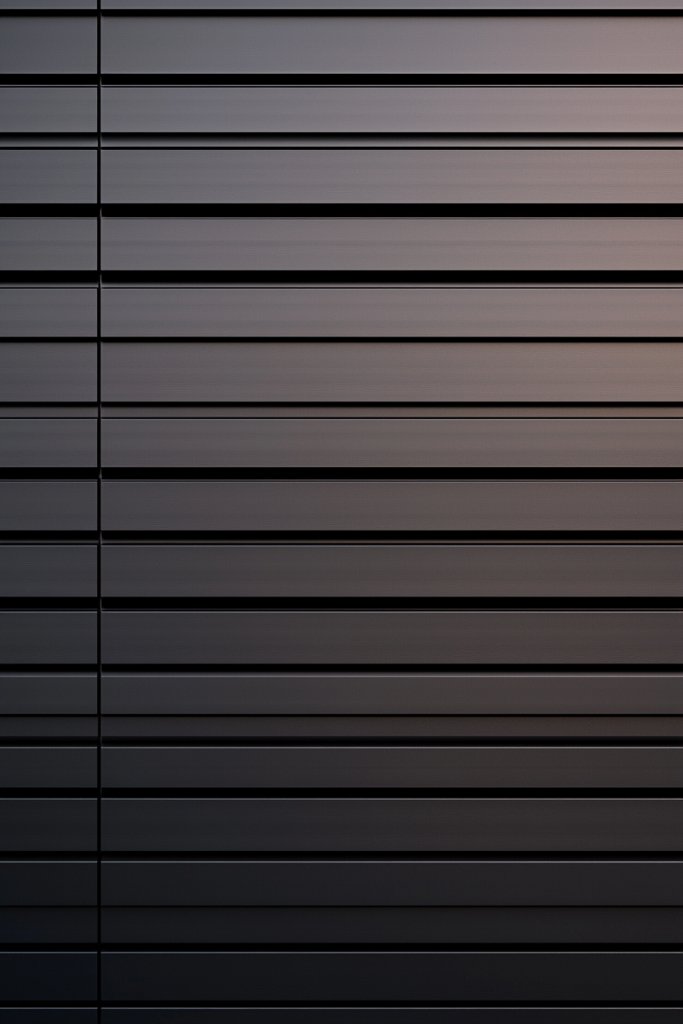
A sleek horizontal cladding instantly transforms your home’s facade into a modern masterpiece, blending simplicity with sophistication. This design element is perfect for creating a clean, streamlined appearance that feels fresh and current.
Imagine a facade clad in smooth, narrow planks of composite wood or fiber cement siding arranged horizontally from ground to roofline. The colors are typically neutral—think soft grays, warm beiges, or crisp whites—that emphasize the horizontal lines and add a sense of elongation and openness.
The surface has a matte or lightly textured finish, giving it a subtle tactile quality. When sunlight hits the cladding, it accentuates the linear pattern, creating gentle shadows that add depth.
The overall look is minimalist yet striking, evoking a sense of calm and order. To implement this, start by selecting high-quality fiber cement or composite panels in your chosen color palette.
Prepare a level surface and attach the panels with hidden fasteners for a seamless appearance. For a beginner-friendly approach, opt for pre-cut panels that snap or slide into place, reducing installation complexity.
Ensure proper weatherproofing and sealing around edges and joints to maintain durability. With a little DIY effort or professional help, this horizontal cladding can elevate your home’s curb appeal with modern elegance.
2. Bold Color Accents for Front Doors and Trims
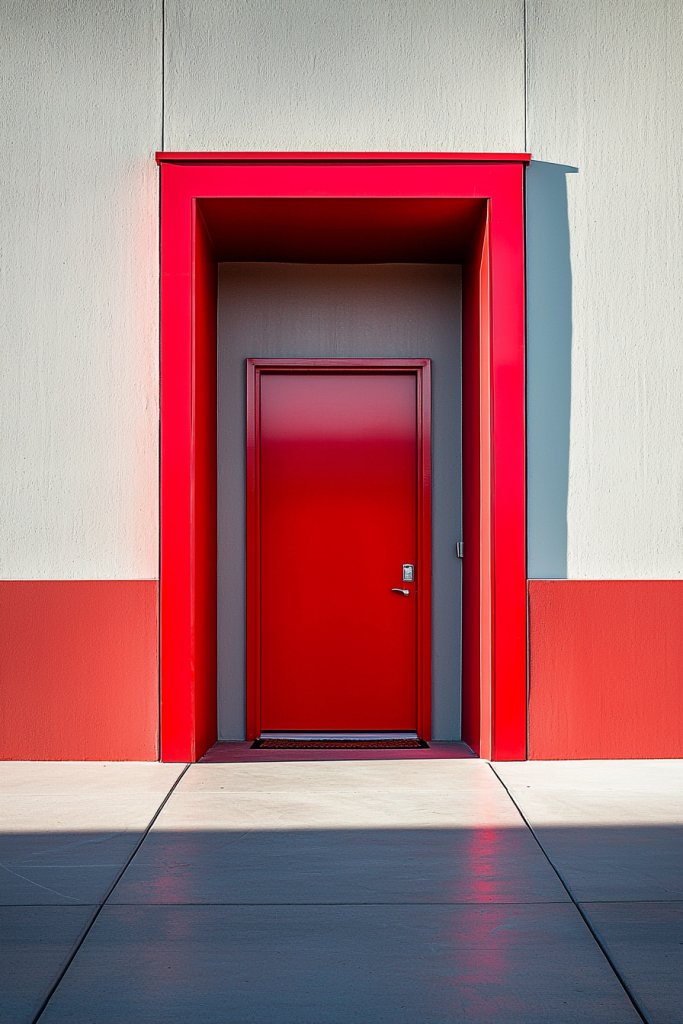
Adding bold color accents to your front door and trims instantly creates a vibrant, welcoming statement on your modern facade. This approach allows you to express personality while enhancing visual interest and curb appeal.
Visualize a crisp white or charcoal-gray exterior punctuated by a striking emerald green, bright red, or navy blue front door. The trims and window frames are painted in complementary or contrasting shades, such as a black door with white trims or a deep teal with metallic accents.
The finish is smooth and glossy, catching the light and drawing the eye. The bold color creates a focal point amid minimalist surroundings, making your entrance feel lively and inviting.
Adding a matching or contrasting mailbox and house numbers amplifies the cohesive look, while subtle metallic hardware adds a touch of modern sophistication. To achieve this, choose a high-quality exterior paint suitable for your climate—look for scrub-resistant, weatherproof finishes.
Start by prepping the surface thoroughly, sanding rough areas and applying a primer if necessary. Use painter’s tape for clean lines and apply at least two coats for vibrancy and longevity.
For those on a budget or seeking less commitment, consider using adhesive vinyl wraps or decals that can be removed or changed easily. This simple yet impactful update can dramatically improve your home’s first impression.
3. Minimalist Lighting Fixtures to Highlight Architectural Features
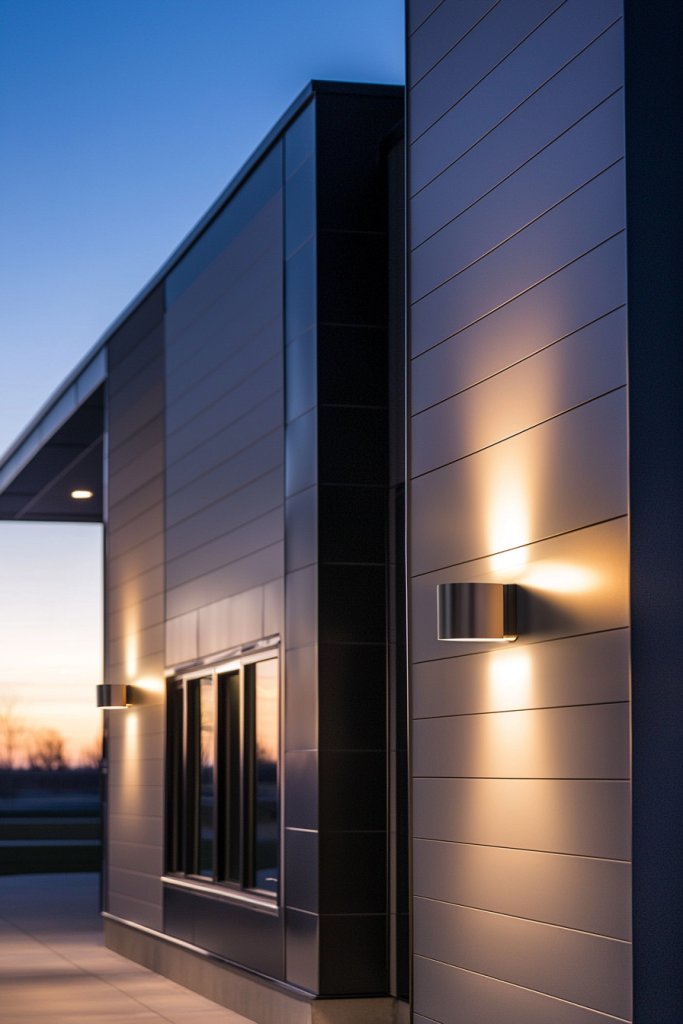
Minimalist lighting fixtures are essential for emphasizing your home’s modern architectural elements while creating a warm, inviting atmosphere at night. Proper lighting enhances textures, shapes, and focal points without overwhelming the design.
Picture sleek, streamlined wall-mounted sconces with a matte black or brushed metal finish flanking the front door or illuminating textured wall panels. These fixtures cast soft, downward or upward light, subtly highlighting the facade’s clean lines and geometric forms.
Embedded LED strip lights along the eaves or beneath floating canopies add a modern glow, creating depth and visual interest. The lighting is unobtrusive yet effective, enhancing the overall aesthetic while providing safety and functionality.
The ambiance at night feels cozy and sophisticated, turning your home into a glowing beacon of contemporary style. To implement, select fixtures with simple geometric shapes—think cylindrical or rectangular designs—that complement your home’s architecture.
Use warm white LED bulbs for a welcoming glow and ensure fixtures are rated for outdoor use. Position fixtures strategically to spotlight key features or pathways, and consider using dimmers to adjust lighting intensity.
For easy installation, opt for fixtures with quick-connect wiring and minimal mounting hardware. This subtle lighting detail can elevate your home’s modern curb appeal effortlessly.
4. Textured Wall Panels for Visual Depth and Interest
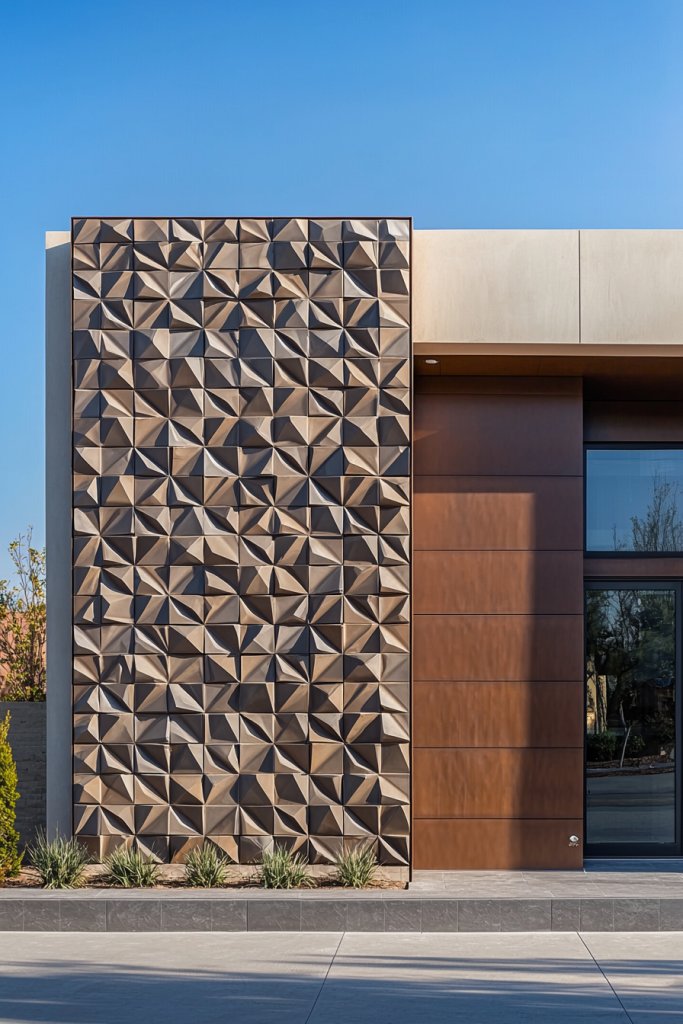
Textured wall panels bring a tactile and visual dimension to your modern front elevation, transforming a flat facade into an engaging display of depth and artistry. They add sophistication and a contemporary edge to your home’s exterior.
Envision panels made from fiberglass-reinforced concrete, wood composites, or metal sheets with geometric or organic patterns—such as ripple, wave, or grid textures. These are installed on select sections of the facade, perhaps framing the entrance or accenting a porch.
The textures catch the light at different angles, creating shifting shadows and visual intrigue. The color palette remains neutral—think slate gray, charcoal, or metallic tones—to keep the look sleek and modern.
The combination of rough and smooth surfaces produces a dynamic interplay that invites touch and visual exploration, elevating your home’s curb appeal. To incorporate textured wall panels, start by choosing materials that suit your climate and style—prefabricated panels are easiest for DIY installation.
Prepare the wall surface by cleaning and leveling it, then attach the panels using appropriate fasteners or adhesive. For beginners, consider panels with interlocking or snap-on features for quick assembly.
Pair with minimalist lighting to accentuate the textures, and keep surrounding surfaces simple to let the panels stand out. This approach provides a sophisticated, modern aesthetic with tactile richness.
5. Large Glass Front Doors for a Modern, Inviting Entrance
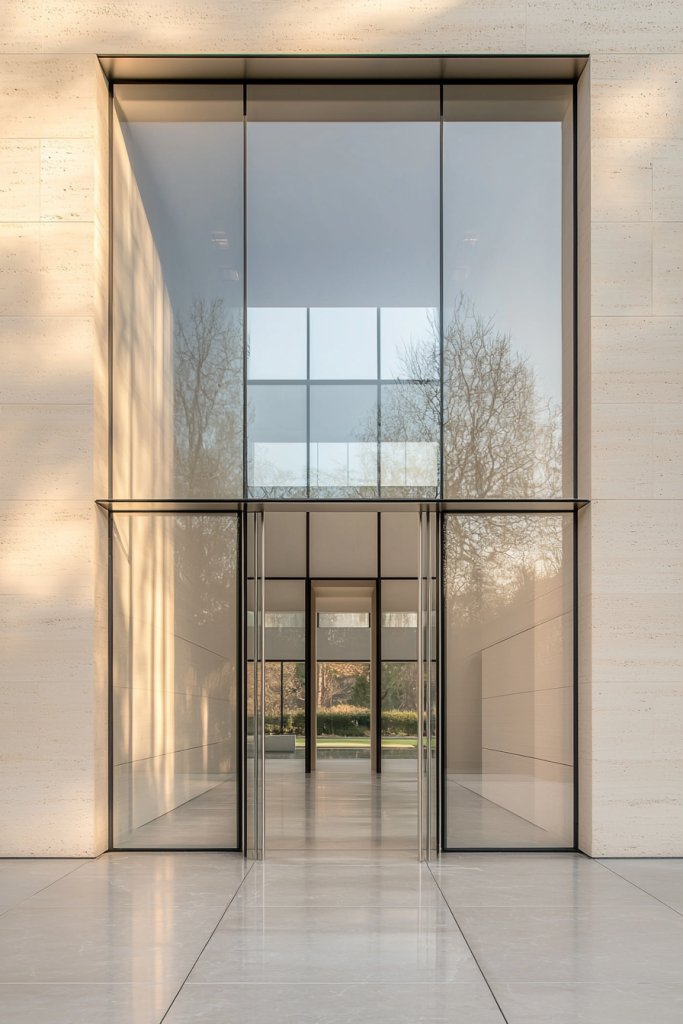
A large glass front door creates a seamless transition between indoor comfort and outdoor elegance, making your entrance both modern and welcoming. It maximizes natural light and adds a sleek architectural statement.
Imagine a floor-to-ceiling glass door with slim black or metallic frames, opening up the facade and inviting views into the entryway. The glass is often tinted or frosted for privacy, but the overall look remains minimal and contemporary.
The clean lines and expansive transparency make the space feel open, airy, and sophisticated. Pair the door with minimalist hardware—like a sleek handle or push plate—and surround it with smooth, neutral-colored walls or textured cladding to enhance its prominence.
The lighting inside can be subtly reflected on the glass, adding warmth and depth during evening hours. To implement, select a high-quality, energy-efficient glass door with durable framing—aluminum, steel, or composite materials work well.
Ensure proper measurement and professional installation for a perfect fit and weatherproofing. For a DIY approach, use pre-made sliding or hinged panels with minimal hardware, but always prioritize safety and insulation needs.
Adding a modern door mat and minimalist house numbers completes the look. This feature instantly elevates your home’s modern curb appeal while creating an inviting, open atmosphere.
6. Asymmetrical Window Placement for a Unique Facade
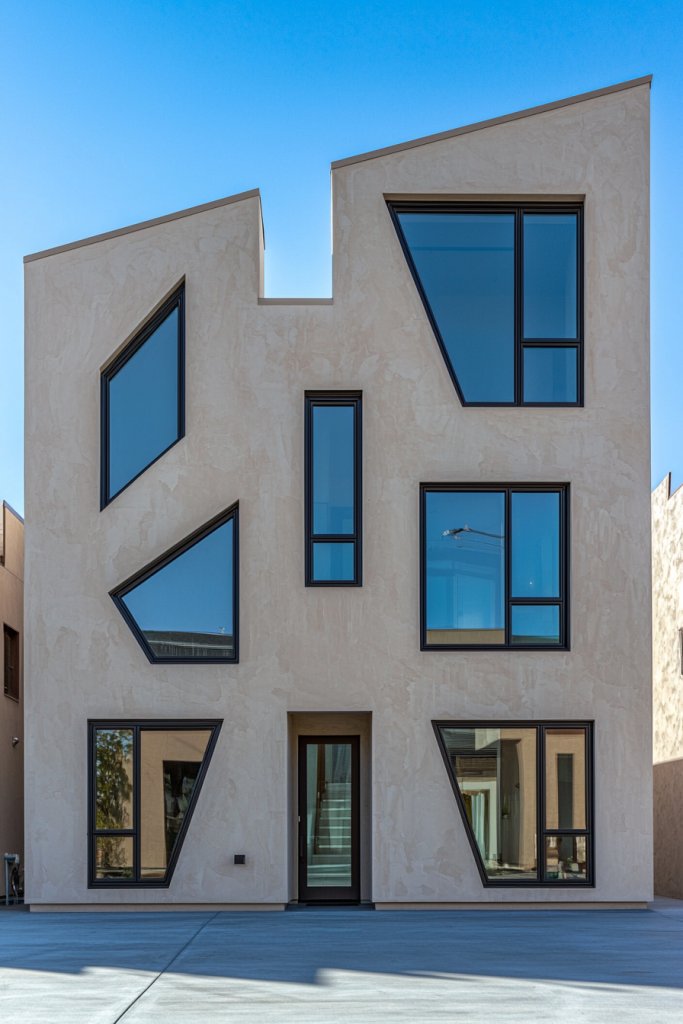
Creating an asymmetrical window arrangement instantly sets your home apart with a modern, edgy vibe. This approach breaks away from traditional symmetrical designs, offering a fresh, dynamic appearance that captures attention and adds visual interest to your facade.
It’s perfect for homeowners wanting to showcase individuality and contemporary style. Imagine large, rectangular windows placed unevenly across your front wall—perhaps one tall, narrow window on one side and a broad, low-set window on the other.
The windows might feature sleek black frames that contrast sharply with the wall’s color, such as crisp white or warm earth tones. This layout creates a playful yet balanced rhythm, emphasizing clean lines and geometric shapes.
The overall effect is a facade that feels both artistic and inviting, especially when complemented with minimalist landscaping and subtle lighting. To implement this look, start by selecting your window sizes and placement based on your home’s dimensions and natural light needs.
Opt for modern, energy-efficient windows with slim profiles, such as aluminum or black-finished frames. Arrange the windows asymmetrically, ensuring visual harmony without strict symmetry.
Hiring a professional for precise measurements and installation is recommended, but basic DIY framing can be manageable with detailed plans. Finish with neutral exterior paint and simple trim to keep the focus on the unique window layout.
7. Incorporating Metal Accents in Railing and Fixtures
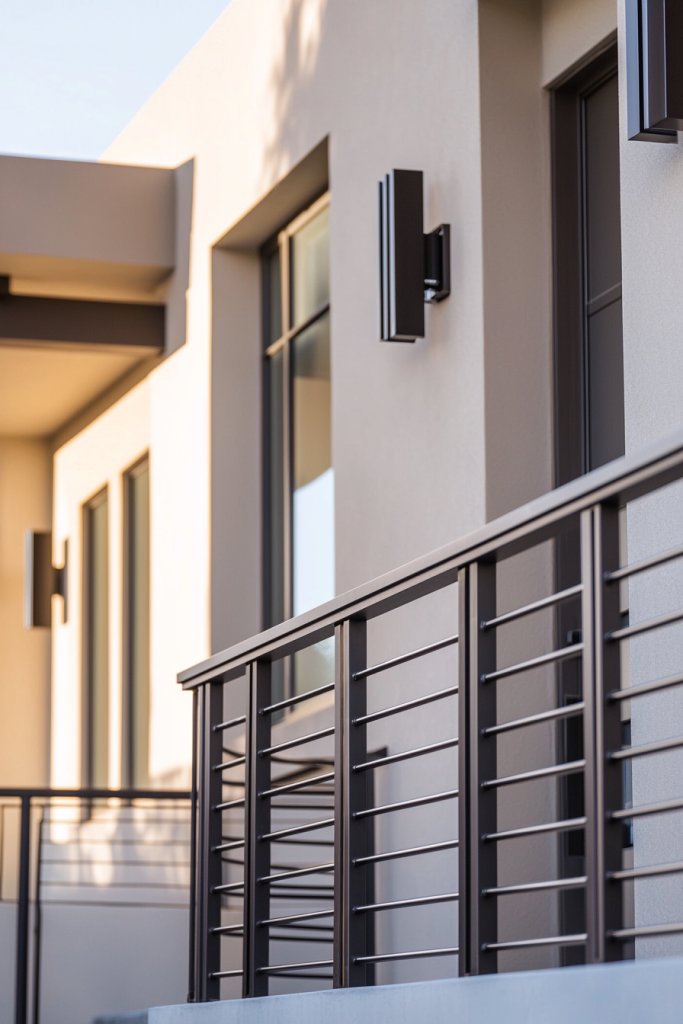
Adding metal accents elevates your front elevation with sleek, modern sophistication. Metal elements—like railings, door handles, and lighting fixtures—bring a contemporary industrial edge that complements minimalist and geometric designs.
When thoughtfully integrated, they create a cohesive, stylish facade that feels both functional and artistic. Picture a front porch with a low-profile, matte black metal railing featuring clean horizontal lines, paired with minimalist, brushed nickel door handles.
Overhead, a modern wall-mounted sconce with a geometric shape casts warm, inviting light, highlighting architectural details at night. Metal fixtures can also include decorative elements like sculpture-inspired door knockers or contemporary address plaques, all with matte or satin finishes that resist weathering.
This combination of textures—smooth, matte, and brushed—adds depth and visual interest while maintaining a sleek, uncluttered feel. To incorporate these accents, choose durable, weather-resistant metals like aluminum, stainless steel, or powder-coated iron.
Select fixtures that match your overall color palette—black, gunmetal, or brushed nickel are popular choices. Start by updating door hardware and porch lighting, then consider installing a modern railing if you have a balcony or porch. These small but impactful details can be easily sourced from hardware stores or specialty suppliers, and many can be installed with basic DIY skills or professional help for a flawless finish.
8. Vertical Garden Walls for a Modern Botanical Touch
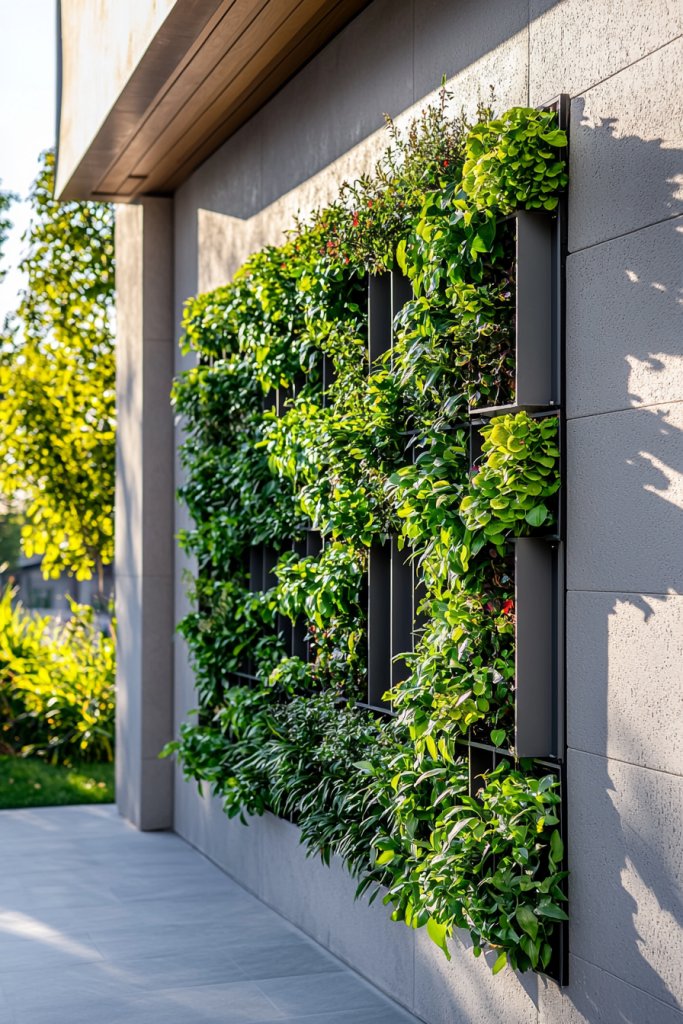
A vertical garden wall introduces a lush, modern botanical element that softens sharp architectural lines while adding fresh texture and color. This feature blends nature with architecture, creating a vibrant focal point that enhances your home’s curb appeal and offers a calming, inviting atmosphere.
Visualize a sleek, rectangular panel of living greenery mounted against your facade—composed of small, dense plants like succulents, moss, or ferns arranged in a geometric pattern. The wall’s surface might be framed with slim, black metal borders, providing a modern contrast to the vibrant green.
The plants, carefully selected for low maintenance and climate suitability, create a textured mosaic that changes with the seasons. When illuminated with subtle LED lighting, this green wall becomes a stunning nighttime feature, adding a touch of serenity and sophistication.
To create a vertical garden wall, start with a modular planter system or a pre-made green wall panel. Choose hardy, low-maintenance plants suited to your climate, such as succulents like Echeveria or Jade plants for minimal upkeep.
Use lightweight, weatherproof materials like fiber-reinforced plastic panels or metal frames with integrated irrigation systems. DIY installation involves mounting the panels securely and planting in predefined pockets, while professional help ensures proper setup and long-term sustainability. This feature not only beautifies your home but also contributes to environmental benefits like improved air quality.
9. Using Natural Stone Veneer for Elegant Facade Textures
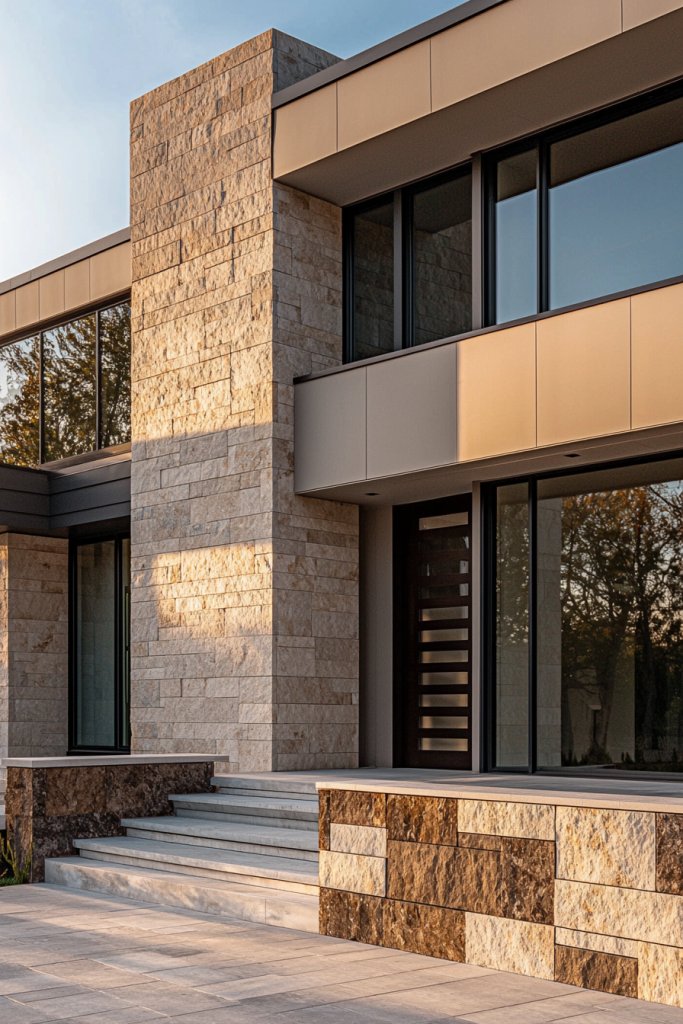
Natural stone veneer instantly adds a sense of luxury and timeless elegance to your front elevation. Its textured surface and rich, earthy tones create a striking contrast against smooth modern finishes, giving your home a sophisticated yet contemporary look.
Picture a facade where sections of your wall are clad in warm, neutral-toned stone veneer—think soft beige, gray, or subtle terracotta—arranged in a linear or irregular pattern. The rough textures of the stone juxtapose beautifully with sleek glass elements and minimalist fixtures, adding depth and tactile interest.
Complement the stone with smooth stucco or painted surfaces in monochrome shades, highlighting the natural variations in the stone’s surface. When sunlight hits the textured veneer, it casts gentle shadows, emphasizing the material’s organic beauty and creating a dynamic visual effect throughout the day.
To incorporate natural stone veneer, start by selecting high-quality panels made from real or manufactured stone. Measure your wall areas precisely, and order enough material to cover those sections with a slight excess for cuts and adjustments.
Prepare the surface by cleaning and leveling it, then follow manufacturer instructions for adhering the veneer—typically involving mortar or adhesive. For a seamless look, consider hiring a professional installer, especially for larger or more intricate patterns. This approach offers a durable, maintenance-friendly upgrade that elevates your home’s curb appeal with a striking, modern touch.
10. Floating Canopies and Overhangs for Architectural Drama
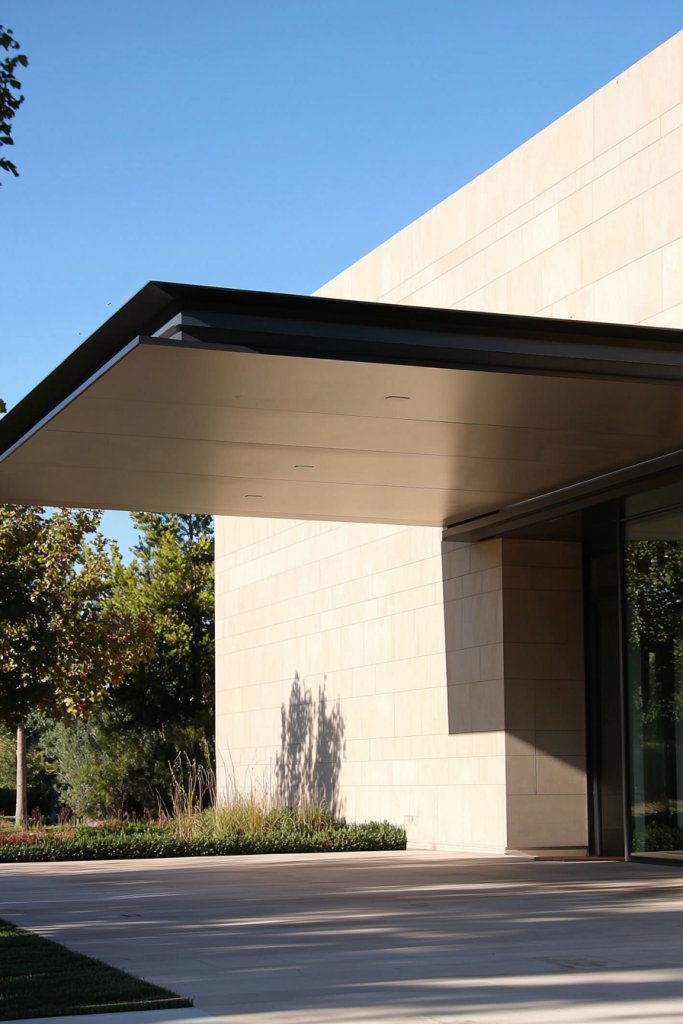
Floating canopies and overhangs add a bold, architectural statement to your front elevation, providing both visual intrigue and functional benefits like shelter and shading. Their clean, minimalist lines create a sense of levitation, making your entrance appear lighter and more modern.
Envision a sleek, cantilevered canopy made from steel or aluminum, extending outward from the facade with no visible supports—giving the illusion of floating. The canopy’s underside could feature recessed lighting or LED strips for a dramatic nighttime glow, emphasizing its architectural form.
The material might be finished in matte black, brushed metal, or wood, depending on your aesthetic preferences. Complement this feature with a modern front door and minimalist lighting fixtures to reinforce the contemporary aesthetic.
The overhang not only adds visual depth but also offers protection from the elements, making your entrance both stylish and practical. To implement this feature, choose durable, weather-resistant materials like powder-coated steel or aluminum, ensuring longevity and low maintenance.
Measure the desired extension carefully, considering the size of your door and porch area. Use sturdy brackets or wall anchors designed for structural loads, and consult a structural engineer if needed for larger spans.
Finish with a sleek, seamless surface—such as composite panels or wood planks—secured flush with the facade. This feature can be installed with basic tools, but professional assistance guarantees safety and precision, transforming your front elevation into a modern architectural masterpiece.
11. Modern Vertical Slat Fencing for Privacy and Style
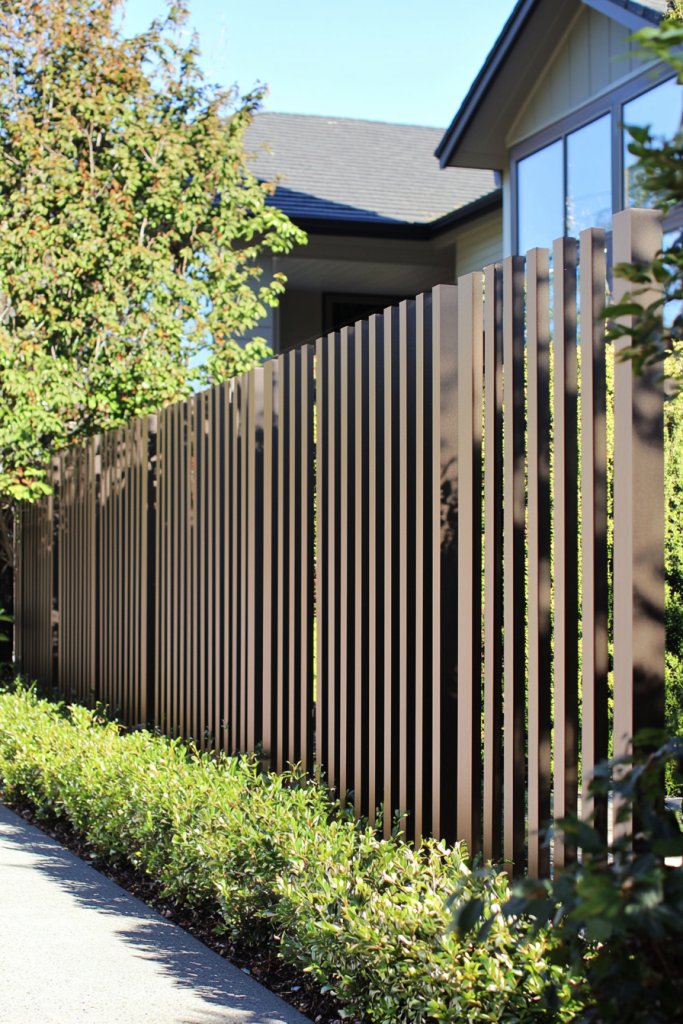
Creating a sleek, modern look for your front yard often involves combining privacy with aesthetic appeal, and vertical slat fencing is the perfect solution. This design features tall, narrow wooden or metal slats arranged vertically with clean, consistent spacing, offering a contemporary alternative to traditional solid fences.
The slats can be stained in natural wood tones like warm oak or walnut, or painted in bold colors such as matte black or crisp white, depending on your overall color scheme. When installed with precision, this fencing creates a rhythmic visual pattern that adds rhythm and texture to your facade, while also allowing light and air to flow through.
It feels light yet protective and can serve as a striking backdrop for modern landscaping elements. Visually, picture a fence composed of evenly spaced vertical planks that extend from the ground to a height that balances privacy with openness—typically around 6 to 8 feet tall.
The slats might be made of smooth cedar, composite material, or metal with a matte finish, adding a sleek, minimalist vibe. The gaps between the slats create interesting shadow plays throughout the day, emphasizing the modern aesthetic.
Complement this with a simple, low-maintenance planting bed with ornamental grasses or clipped boxwoods at the base, and your fence becomes a stylish frame for your home’s entrance. The overall effect combines simplicity with sophistication, perfect for stylish urban or suburban settings.
To implement this look, start by measuring the desired fence height and length, then choose durable materials like pressure-treated wood, composite, or powder-coated metal. For a beginner-friendly approach, consider pre-made slat panels or modular fencing kits available at hardware stores.
Attach the slats to sturdy vertical posts set in concrete for stability, spacing them evenly with spacers for a uniform appearance. Finish with weatherproof paint or stain to protect the material from the elements. For added flair, incorporate LED strip lighting along the top edge for a subtle glow at night, making your modern vertical slat fence a standout feature.
12. Geometric Patterned Concrete or Pavers for Pathways
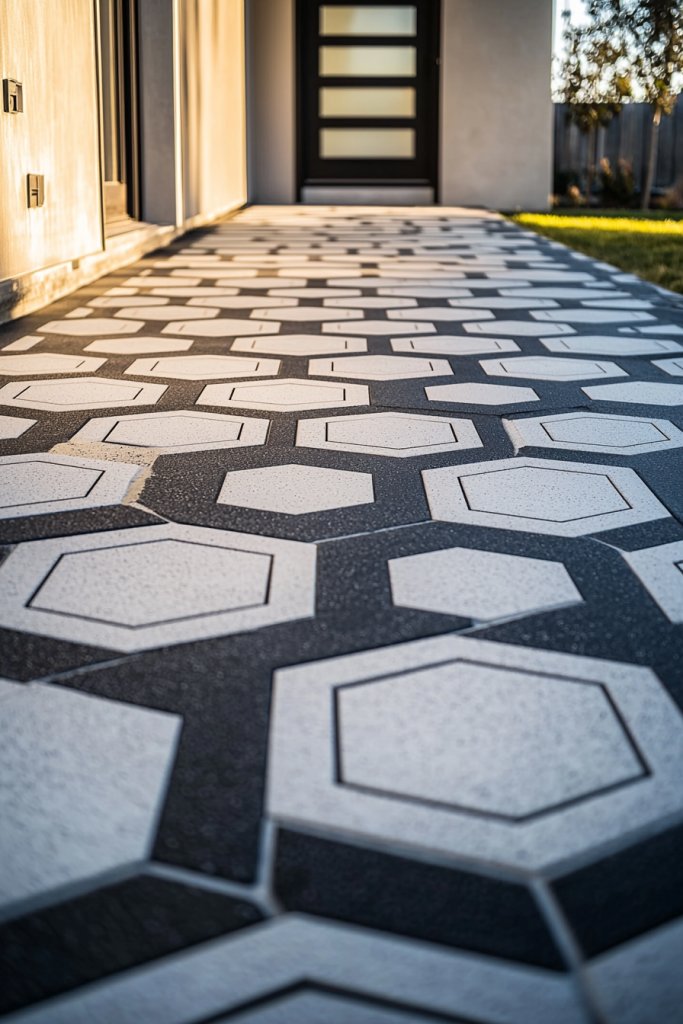
Transforming your front yard pathway into a striking visual feature can dramatically enhance your modern home’s curb appeal, and geometric patterned concrete or pavers are an excellent choice. This idea involves designing pathways with bold, repetitive shapes—such as hexagons, diamonds, or chevrons—that create a sense of order and visual interest.
Using contrasting colors or finishes, like charcoal gray and crisp white, can make the pattern pop. The textured surface adds tactile appeal, while the crisp geometric lines lend a contemporary, artistic vibe that ties the overall modern design together.
Imagine walking along a pathway composed of large hexagonal pavers in a matte concrete finish, with narrow strips of black grout creating sharp, clean lines between each shape. Or visualize interlocking diamond-shaped tiles in sleek porcelain, arranged to form a dynamic, eye-catching pattern across your driveway or front entrance.
The textures vary from smooth to lightly textured, providing both visual depth and a non-slip surface. When combined with minimalist landscape elements—such as metal planters or sculptural lighting—the patterned pathway becomes a focal point that guides visitors and elevates your home’s aesthetic.
The design balances form and function seamlessly, making your entrance inviting and modern. To create this look, you’ll need patterned pavers or stamped concrete with geometric designs, along with grout or joint filler in contrasting shades.
Start by preparing a level base of gravel and compacted soil, then lay your pavers according to your chosen pattern, ensuring tight joints for stability. Use a rubber mallet to set each piece firmly in place.
Seal the surface with a clear concrete sealant or a matte finish to enhance durability and appearance. For a DIY-friendly option, consider pre-formed concrete tiles with built-in patterns that can be easily installed with mortar or adhesive. This approach offers a sleek, contemporary pathway that combines artistic flair with practical durability.
13. Monochrome Color Schemes with Contrasting Details
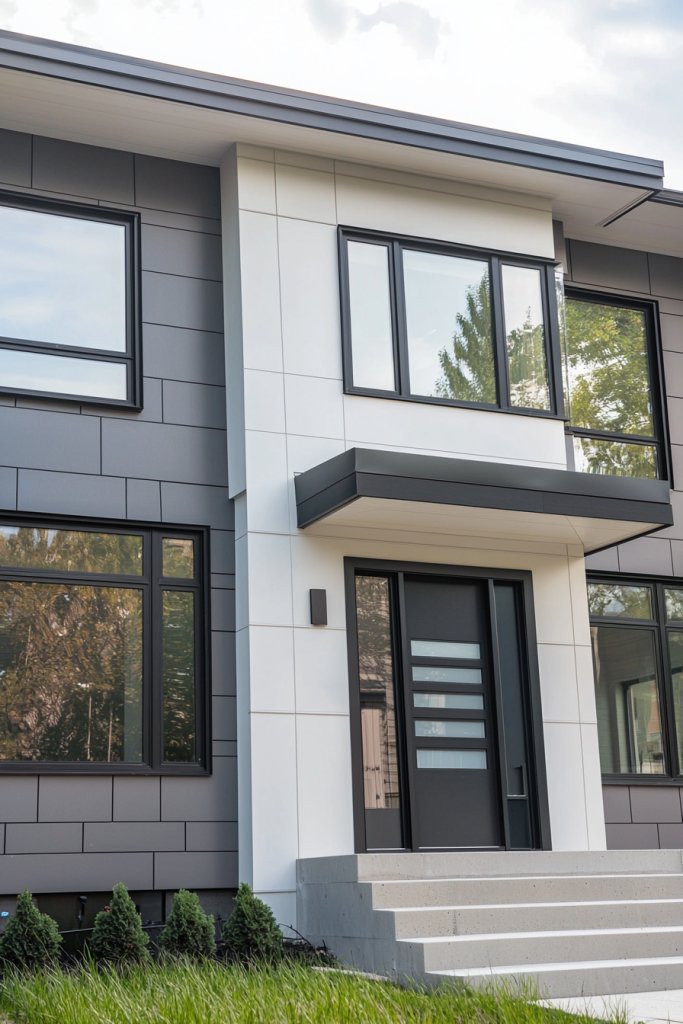
A monochrome color palette is an elegant way to achieve a modern, cohesive look for your front elevation, emphasizing simplicity and sophistication. This approach involves choosing shades within a single color family—like shades of gray, beige, or black—and then adding contrasting elements to create visual interest.
For example, pairing a soft charcoal gray façade with white trims and dark window frames can produce a striking, balanced contrast. The key is to select a consistent color base and incorporate texture variations—such as matte walls with glossy accents—to prevent the design from feeling flat.
Visualize a front elevation painted in a warm, medium gray tone, with crisp white trims outlining large, rectangular windows. The front door could be a darker, charcoal hue, providing depth, while modern wall-mounted lighting fixtures in matte black add subtle contrast.
Textures like smooth stucco combined with matte or semi-gloss finishes deepen the visual layer without disrupting the monochrome scheme. The overall aesthetic feels calm, refined, and timeless, with each element harmonizing seamlessly.
This minimalist approach allows architectural details and decorative accents to stand out, making your home appear both modern and effortlessly stylish. To implement this concept, choose a primary color palette—such as shades of gray, beige, or black—and stick to it across all exterior surfaces.
Use high-quality exterior paint with a matte or semi-gloss finish for walls, and select trims, window frames, and fixtures in contrasting tones or finishes. Incorporate metallic or ceramic decorative elements like house numbers or light fixtures in black or brushed nickel to enhance contrast subtly.
Keep the overall design clean and uncluttered, focusing on balanced proportions and sharp lines. This unified monochrome scheme creates a sleek, modern curb appeal that is both versatile and visually compelling.
14. Incorporating Modern Sculptural Elements as Focal Points
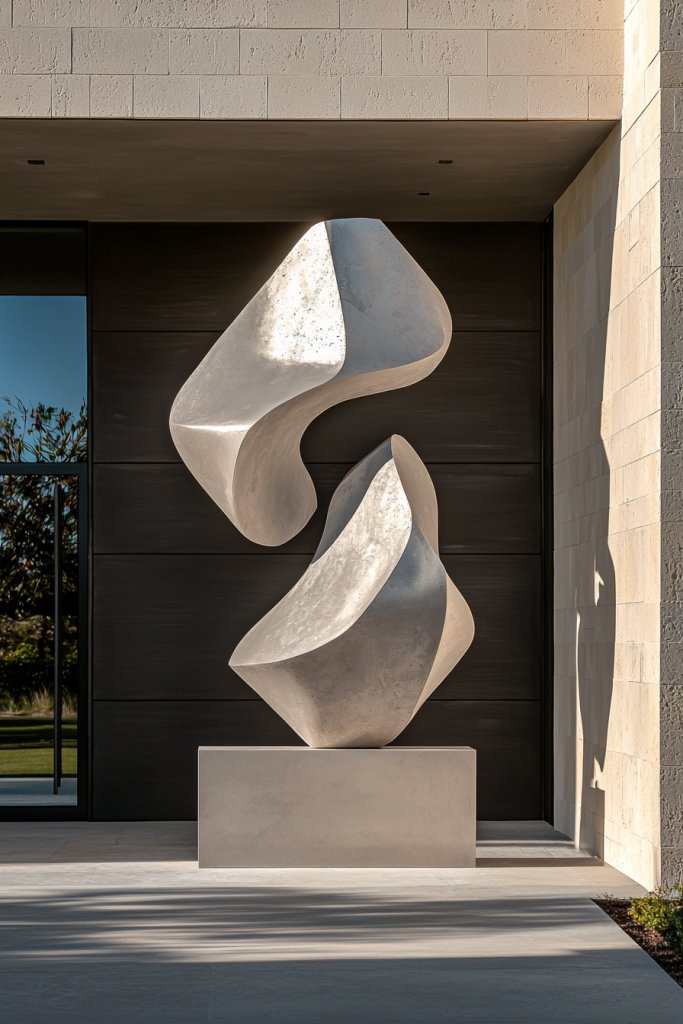
Adding sculptural elements to your front elevation introduces a bold, artistic statement that defines your home’s modern aesthetic. These focal points can be abstract sculptures, minimalist geometric forms, or contemporary art pieces made from materials like metal, concrete, or polished stone.
Strategically placed, these sculptures serve as visual anchors that draw the eye and create a memorable first impression, transforming your facade into an open-air gallery of modern art. Picture a sleek, stainless steel sculpture with flowing curves positioned near the entrance, or a large, geometric concrete block with clean lines set against a minimalist wall.
These elements can also be functional, such as modern sculptures that double as planters or lighting fixtures. The key is to select pieces with bold shapes, simple lines, and a refined finish—think polished metal, matte concrete, or smooth ceramics.
Complement these with subtle lighting, like uplights or wall washers, to highlight their form at night, heightening their sculptural impact. When integrated thoughtfully, these focal points elevate your home’s curb appeal and reflect a sophisticated, contemporary style.
To incorporate modern sculptural elements, start by selecting or commissioning pieces that resonate with your aesthetic—either from local artists or online stores. Place the sculptures in prominent locations, such as near the pathway, beside the front door, or within a landscaped bed with low-maintenance plants.
Ensure the sculptures are proportionate to their surroundings and are protected from weathering with suitable finishes or coatings. Use subtle outdoor lighting to accentuate their form after dark. With a few bold, artistic touches, your front elevation becomes a striking showcase of modern design and personal style.
15. Frameless Glass Balustrades for a Sleek Balcony Look
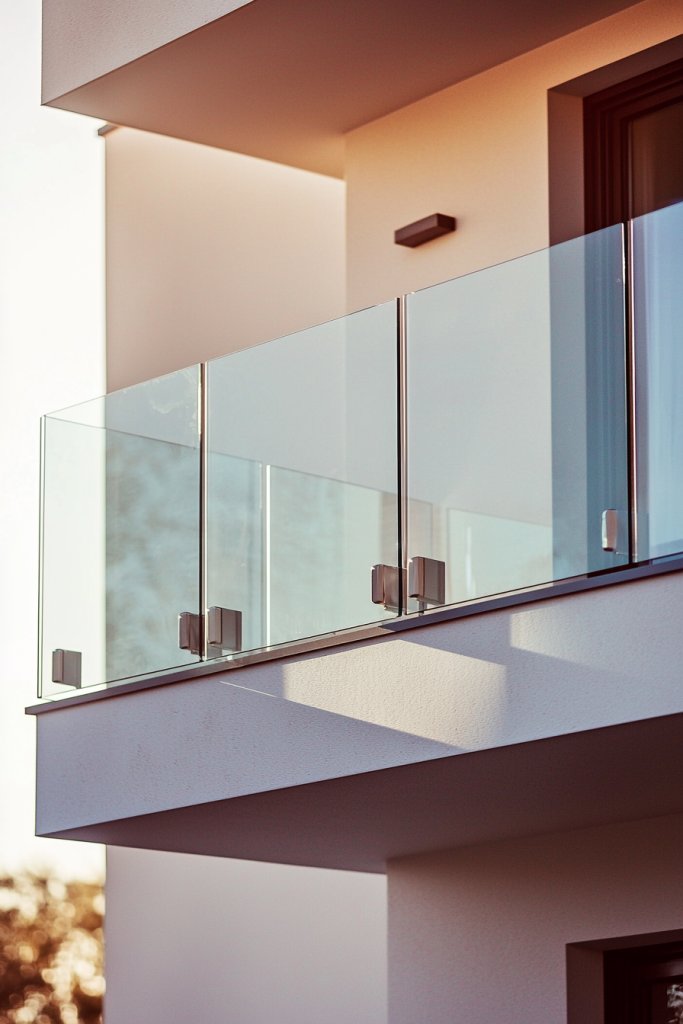
Frameless glass balustrades bring a striking sense of openness and modern elegance to your home’s balcony or terrace, offering unobstructed views and a clean, minimalist aesthetic. These glass panels are typically made of tempered, toughened glass held in place with discreet metal fixtures or clamps, creating the illusion of a floating barrier.
Their transparency enhances the sense of space, making your outdoor area feel larger and more connected to the surroundings, while also adding a contemporary, luxurious touch. Visualize a balcony with floor-to-ceiling glass panels that seem to hover effortlessly, protected by slim stainless steel or black metal clamps.
The transparent surface reflects light beautifully and allows natural views to take center stage—whether it’s lush greenery, cityscapes, or a sunset. The smooth, sleek glass contrasts with textured wall surfaces or greenery below, creating a striking aesthetic harmony.
When paired with minimalist furniture and lighting, frameless glass balustrades elevate the overall modern appeal of your front elevation, making it look sophisticated and inviting. To install frameless glass balustrades, start by choosing tempered glass panels of appropriate thickness (generally 10-12mm for safety).
Consult a professional to ensure proper measurement, secure anchoring, and compliance with local safety standards. The mounting hardware, typically stainless steel clamps or channels, should be weather-resistant.
Regular cleaning with glass cleaner will keep the panels sparkling and clear. This simple yet high-end feature adds a sleek, contemporary edge to your home’s exterior and offers an effortless way to modernize your front elevation.
16. Incorporating LED Strip Lighting for Nighttime Curb Appeal
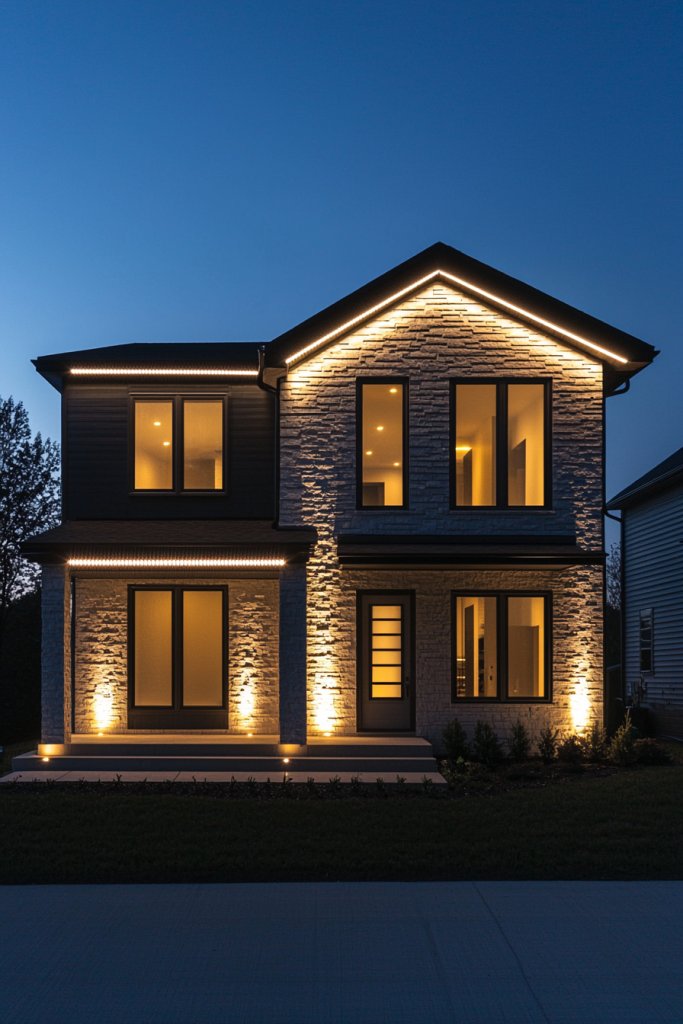
Adding LED strip lighting to your front elevation transforms your home into a luminous, welcoming beacon after sunset. This technique highlights architectural features, creating a subtle glow that enhances visual appeal and safety, making it an essential modern upgrade that draws admiration both day and night.
Imagine soft, warm white LED strips tucked beneath a floating canopy or along the edges of textured wall panels, casting a gentle light that accentuates clean lines and geometric shapes. The lighting subtly outlines door frames, window sills, or pergolas, creating an inviting ambiance.
The glow reflects softly on natural stone or matte-finished surfaces, adding depth and sophistication. You might also incorporate color-changing LEDs for a playful or elegant mood, depending on your style.
The overall effect is a sleek, contemporary look that elevates your home’s curb appeal while ensuring safety and visibility during evening hours. To implement this idea, start by choosing flexible LED strip lights with a suitable color temperature—warm white for cozy ambiance or cool white for a modern feel.
Measure the lengths needed around key architectural features, then purchase a compatible LED controller and power supply. Mount the strips using adhesive backing carefully aligned along edges or beneath overhangs, ensuring a clean, seamless look.
For safety and durability, opt for waterproof options if exposed to the elements. Once installed, connect and control your lighting via a remote or smartphone app, adjusting brightness and colors as desired for a stunning, personalized nighttime curb appeal.
17. Using Matte Finishes on Exterior Surfaces for a Sophisticated Feel
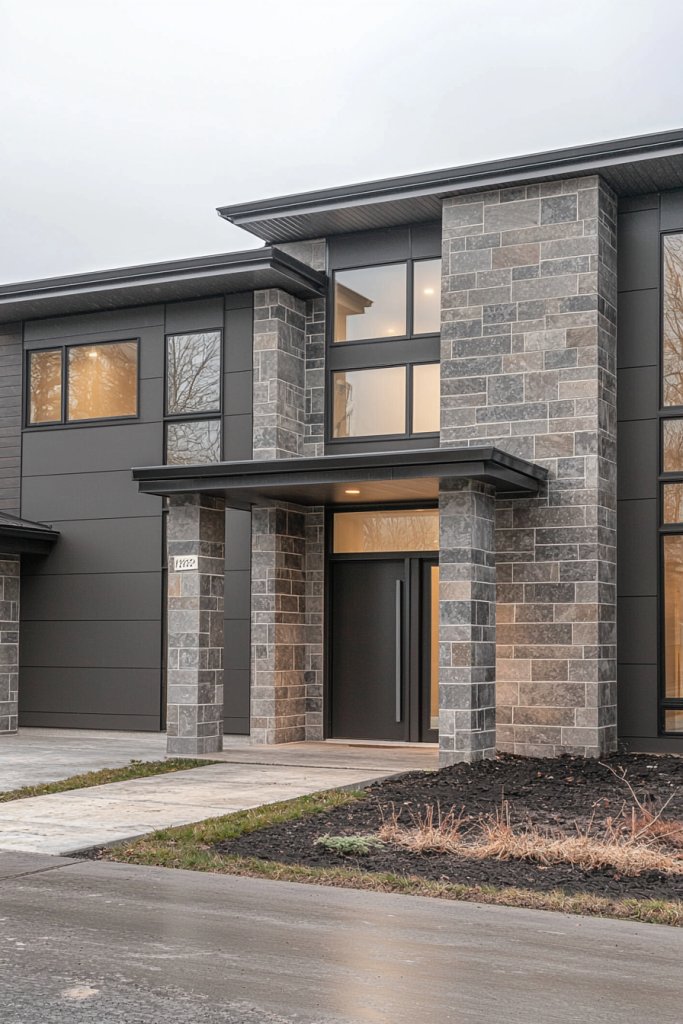
Matte finishes have become a signature of modern elegance, offering a refined, understated look that elevates any front elevation design. They reduce glare, soften the overall appearance, and lend a sophisticated, contemporary vibe that’s perfect for minimalist or industrial-inspired homes.
Picture a facade clad in matte natural stone veneer or painted stucco in shades like charcoal gray, soft beige, or deep navy—colors that absorb light rather than reflect it. The matte surface feels velvety to the touch and minimizes imperfections, giving the exterior a smooth, uniform appearance.
Textured plaster with a matte finish emphasizes clean, crisp lines and enhances architectural details without overwhelming them. This finish also creates a calm, inviting atmosphere, inviting visitors to explore further.
The subtle play of shadows on matte surfaces emphasizes form and depth, making your home stand out with quiet confidence. To achieve this look, select high-quality matte exterior paint or coatings designed specifically for outdoor use.
For textured surfaces like plaster or stucco, opt for matte plaster or stucco mixes that are durable and weather-resistant. If working with existing surfaces, consider applying a matte sealant or finishing coat to mute glossiness.
Remember that matte finishes are less forgiving of dirt and fingerprints, so regular cleaning with gentle soap and water will keep your facade looking pristine. For a sleek, modern aesthetic, pair matte surfaces with minimalist hardware and lighting, creating a sophisticated curb appeal that lasts.
18. Creating a Symmetrical Facade with Modern Elements
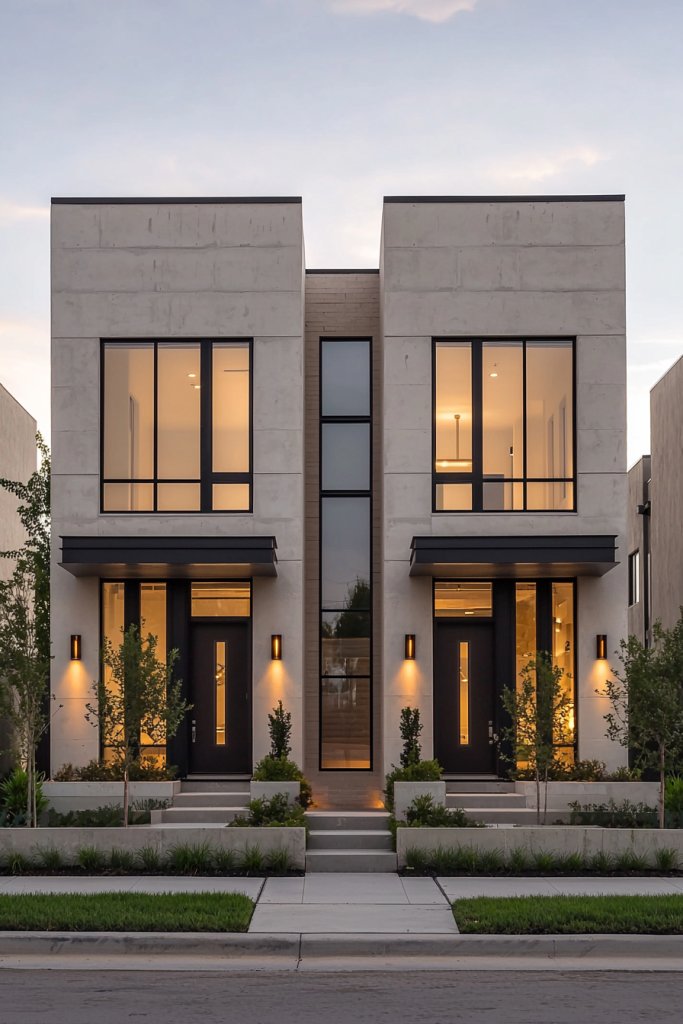
Symmetry in front elevation design creates a balanced, harmonious appearance that exudes modern elegance and order. When combined with contemporary elements, symmetrical facades can make your home appear more structured and visually appealing, offering a timeless yet fresh look.
Visualize a front with perfectly aligned windows on either side of a central, expansive glass door. The design features clean lines and geometric shapes—say, rectangular windows with slim, black aluminum frames, paired with matching wall-mounted light fixtures.
The color scheme might be monochrome—white and black, or earth tones with contrasting trims—emphasizing crisp symmetry. The addition of evenly spaced textures, such as horizontal cladding or vertical slats, enhances the cohesive look.
The overall effect is a home that feels both modern and inviting, with a sense of stability and visual clarity that appeals to contemporary tastes. To craft this symmetrical facade, start by designing your layout with balanced elements—matching window sizes and placements, central entry points, and aligned architectural details.
Use materials like smooth stucco, metal panels, or timber cladding to add texture while maintaining clean lines. Incorporate identical light fixtures and hardware on both sides to reinforce symmetry.
When planning, ensure that structural elements like beams or supports are evenly spaced and aligned. This approach not only creates visual harmony but also simplifies construction, making it easier to achieve a polished, modern curb appeal that stands out.
19. Incorporating Textured Plaster or Stucco with Clean Lines
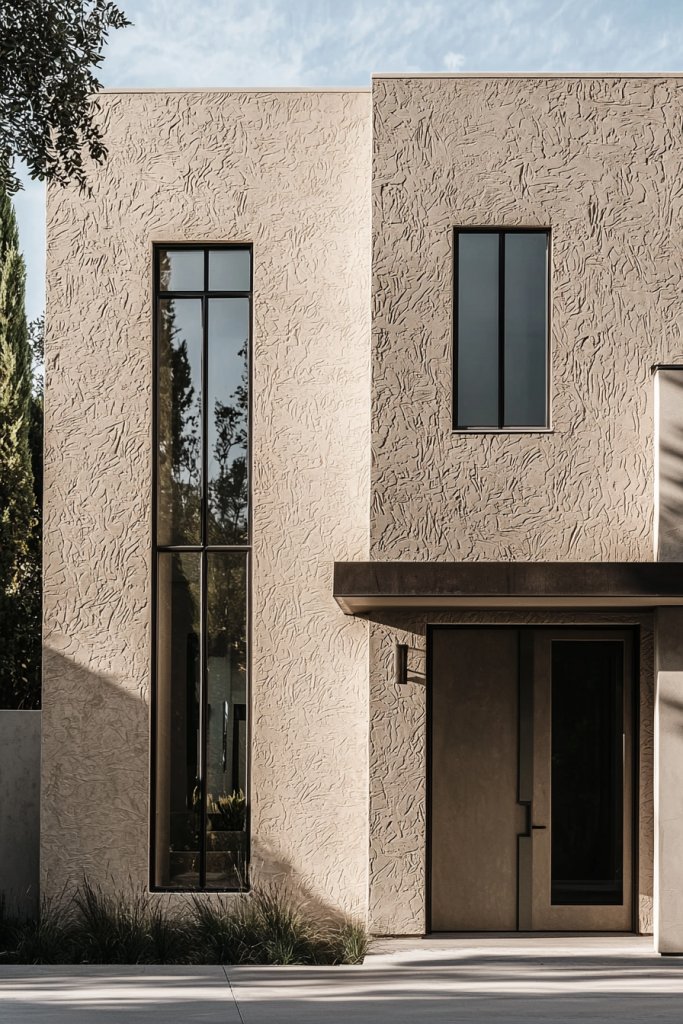
Textured plaster or stucco adds visual interest and depth to a modern front elevation, balancing tactile richness with sleek, clean-lined architecture. When executed well, it creates a sophisticated facade that feels both contemporary and timeless.
Imagine a smooth, matte stucco finish with subtle horizontal or linear textures, accentuated by sharp, precise edges. The texture could be achieved through techniques like knockdown, sand finish, or lash coat, resulting in a surface that catches light differently throughout the day.
Pairing textured walls with minimalist features—such as slim-profile windows and streamlined doors—enhances the modern aesthetic. The neutral color palette, like warm beige, cool gray, or crisp white, complements the textured surface, creating a refined yet inviting look.
This combination emphasizes the architectural lines and provides an understated backdrop for decorative lighting or sculptural details. To incorporate textured plaster or stucco, begin by selecting high-quality, exterior-grade materials suited for your climate.
Prepare the surface thoroughly, ensuring it is clean and free of cracks. Apply the textured finish using specialized tools—such as trowels, sponges, or brushes—to create the desired pattern.
For a sleek, modern look, keep the textures subtle and avoid over-complicating the surface. Finish with a protective sealant to preserve the texture and color, and complement the look with modern hardware and lighting fixtures. This approach results in a facade that’s rich in detail yet remains minimalist and stylish.
20. Modern Canopy Designs with Metal or Wooden Elements
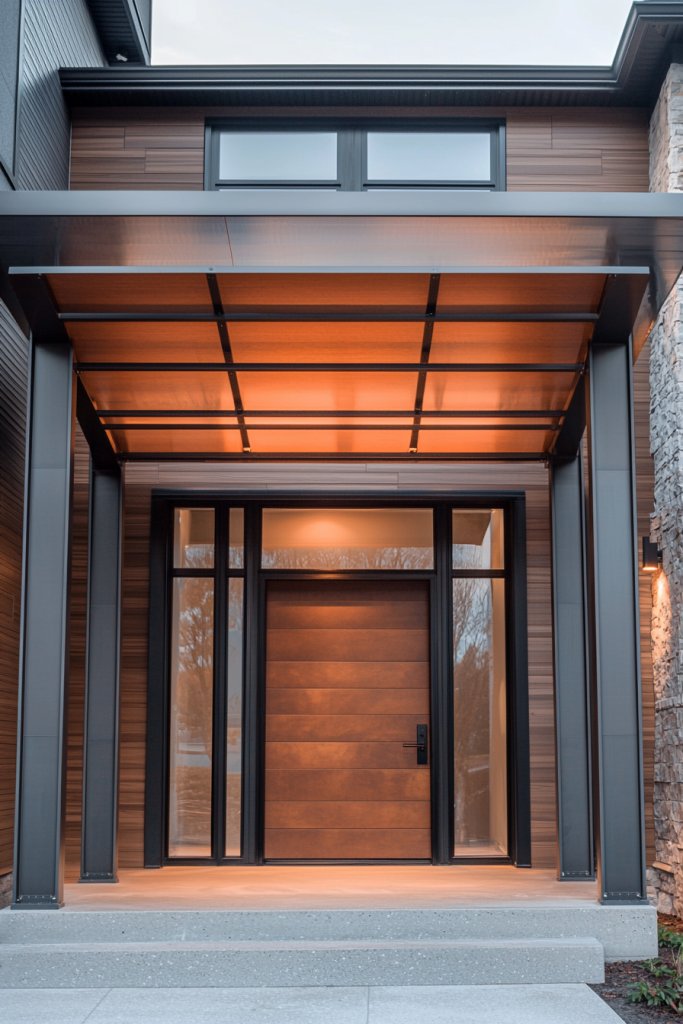
A modern canopy provides both functional shelter and a striking architectural feature that frames your front entrance with style. Using sleek metal or warm wooden elements, this feature adds dimension, protects your porch from the elements, and elevates your home’s modern aesthetic.
Picture a cantilevered canopy crafted from black powder-coated steel or light-colored timber that extends gracefully over your doorway. The canopy’s clean, geometric lines create a sense of openness and sophistication, especially when paired with minimalist lighting fixtures embedded underneath.
The combination of materials—smooth metal or textured wood—adds contrast and visual interest. Incorporate subtle details like integrated LED lighting strips or slim supports to keep the design sleek and uncluttered.
The canopy’s design should complement the overall facade, emphasizing horizontal or linear motifs that enhance the modern look while providing practical shelter from rain or sun. To implement this, start with a detailed plan that includes measurements of your entryway and desired overhang length.
Choose durable metal or wooden beams, ensuring they are treated for weather resistance. Use steel brackets or hidden supports for a clean appearance, and consider adding LED strip lights underneath for nighttime illumination.
For installation, anchor the supports securely into your porch or wall, ensuring they are level and stable. Finish with weatherproof paint or sealant, and add subtle decorative elements like modern pendant lights or sleek signage. This modern canopy design seamlessly combines form and function, making your entrance both practical and visually stunning.
21. Installing Contemporary House Numbers with Backlighting
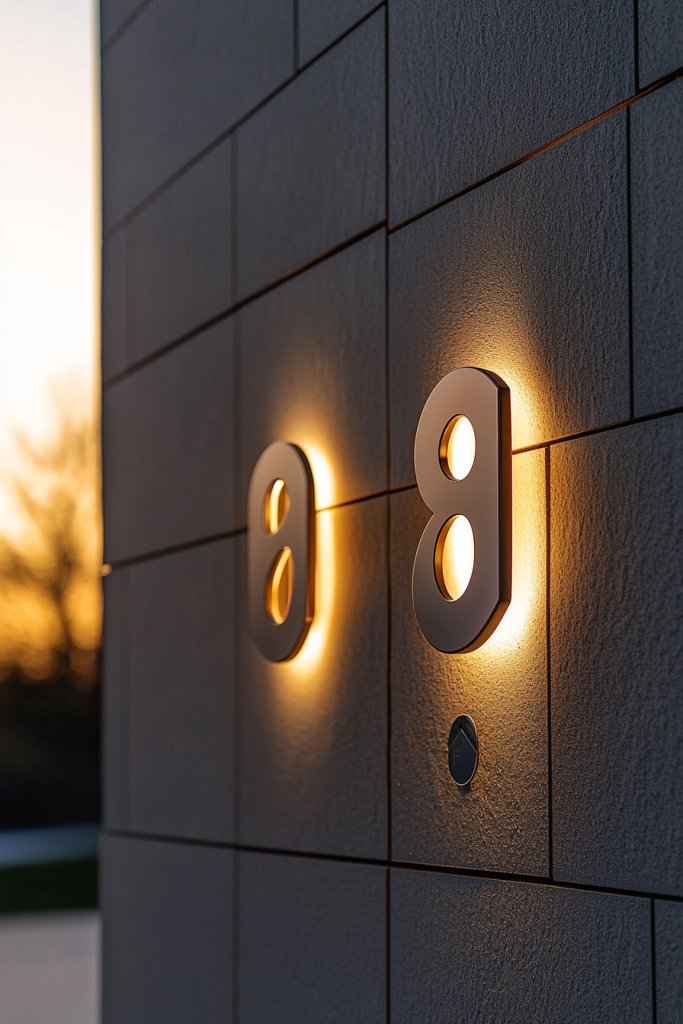
Adding modern house numbers with backlighting instantly elevates your home’s curb appeal by blending functionality with sleek design. These illuminated numerals create a striking focal point, making your address both visible and stylish at night, which is especially helpful for visitors and emergency services.
Imagine large, bold numbers made from brushed metal or matte black acrylic, mounted directly onto your facade. The backlighting casts a soft, ambient glow that highlights the numbers without overpowering the overall look.
The light subtly accentuates the texture of your wall, whether it’s smooth plaster or textured stone, and creates a contemporary, polished vibe. This setup adds a warm, inviting glow to your entrance and enhances the modern aesthetic with a touch of sophistication.
To implement this, start by selecting house numbers made from durable, weather-resistant materials like aluminum, stainless steel, or acrylic. Install them securely onto your exterior wall using appropriate anchors.
For backlighting, opt for LED strip lights or small, energy-efficient spotlights mounted behind the numbers to produce an even glow. Ensure electrical wiring is concealed for a clean finish, or consider battery-operated options for easier installation. Position the lighting to avoid glare and maximize visibility, and customize the brightness based on your preference for a subtle or more pronounced effect.
22. Adding a Stylish Porch with Modern Seating and Decor
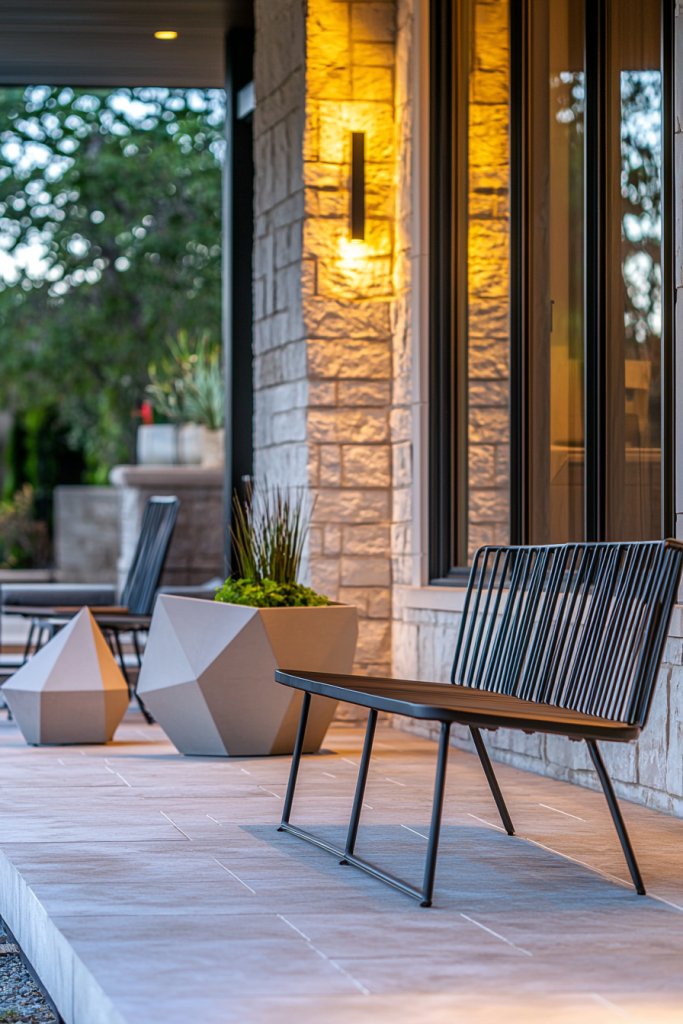
A modern porch transforms your home’s entrance into a welcoming, stylish space that sets the tone for your entire property. Incorporating sleek seating and contemporary decor creates an inviting area perfect for relaxing or greeting guests in style.
Visualize a streamlined porch featuring a minimalist, low-profile bench or a set of modern armchairs with clean lines in neutral tones like gray, black, or beige. Complement these with textured cushions — perhaps a soft, cream-colored throw blanket with a chunky knit pattern — and a small, geometric side table in matte black or metallic finish.
Overhead, a slim, modern pendant light or a simple canopy in metal or wood frames the space, adding architectural interest. The overall palette might include a mix of concrete, metal, and natural wood accents, with decorative objects like sleek ceramic vases or sculptural lanterns to enhance the contemporary vibe.
This creates a cozy yet stylish nook that feels both functional and aesthetically pleasing. To bring this idea to life, start by selecting durable, weather-resistant furniture with minimalist designs.
Place the seating in a way that encourages conversation and maximizes space, perhaps with a narrow walkway or a small outdoor rug underneath. Add cushions and throws to inject texture and comfort.
For decor, incorporate modern lighting fixtures like pendant lamps or wall-mounted sconces, and consider placing a few decorative ceramics or metallic lanterns on the side table. Finish by choosing a neutral color scheme that complements your home’s exterior, and ensure all furniture and accessories are sealed or treated for outdoor durability.
23. Integrating Water Features like Minimalist Fountains
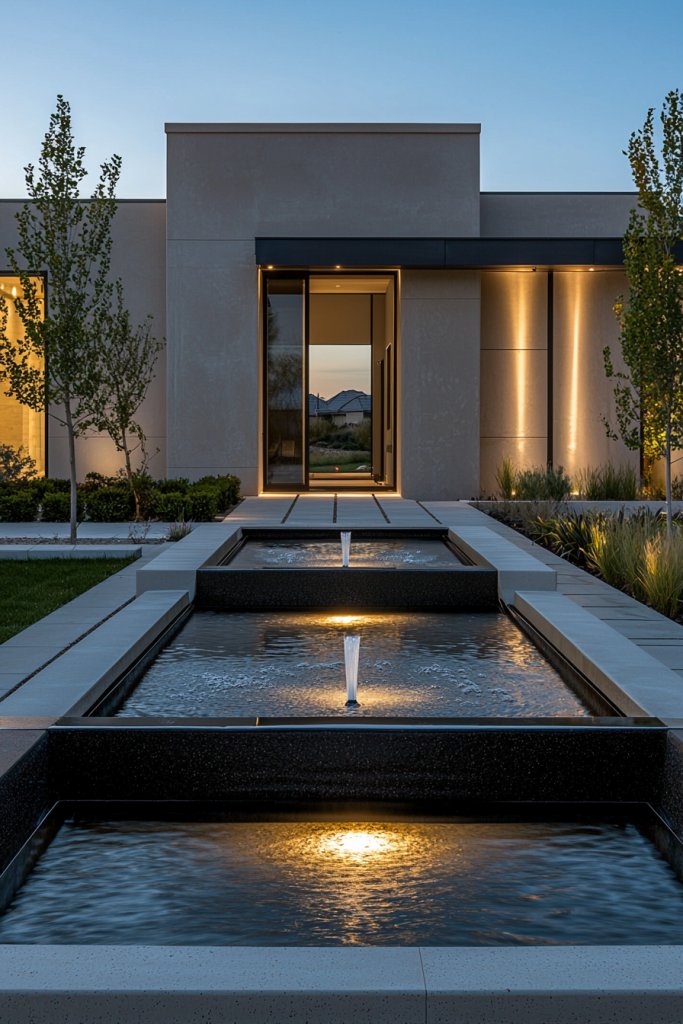
Incorporating a water feature such as a minimalist fountain adds a tranquil, elegant element to your front elevation, creating a soothing focal point that enhances your home’s modern aesthetic. Picture a sleek, rectangular or circular fountain crafted from smooth, polished stone or concrete, with clean lines and a simple design.
Water flows gently from a narrow slit or a small, unobtrusive spout, creating a calming sound that invites relaxation. Surround the fountain with minimalist landscaping—perhaps gravel, large stones, or a few sculptural planters in muted tones—to maintain the modern look.
The water feature’s subtle illumination at night, achieved with integrated LED lights, adds a magical glow, emphasizing the tranquil ambiance. The overall effect is a harmonious blend of nature and architecture, offering a peaceful visual and auditory experience right at your doorstep.
To implement, select a water feature made from durable, weatherproof materials like concrete, stainless steel, or stone. Position it on a sturdy, flat surface, and connect it to a reliable power source or use solar-powered pumps for eco-friendly operation.
Keep the surrounding area minimal—use simple paving or a sleek concrete slab—and add decorative elements like smooth river stones or minimalist sculptures nearby. Regular maintenance, such as cleaning the pump and refilling water, ensures the fountain remains a beautiful, serene feature year-round. This addition transforms your front yard into a modern oasis that welcomes guests with tranquility.
24. Using Large-Scale Patterned Tiles for Entryway Floors
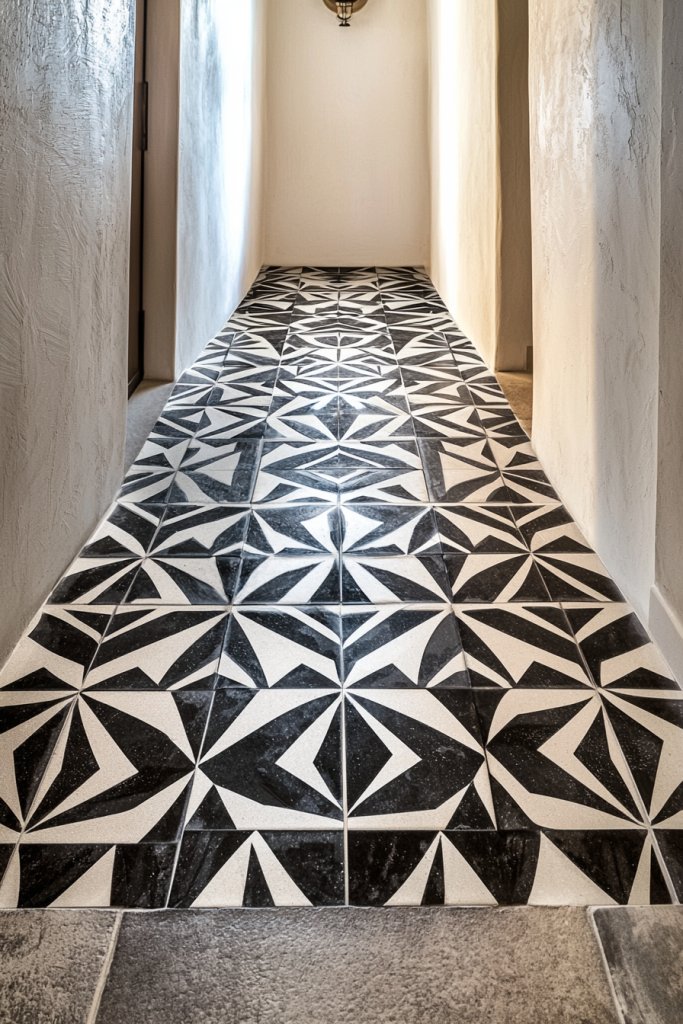
A striking way to modernize your front elevation is through the use of large-scale patterned tiles for your entryway floor, transforming an ordinary walkway into a captivating design statement. Envision oversized tiles with bold geometric patterns or subtle textures in contemporary shades like charcoal, white, or muted earth tones.
These tiles can feature intricate mosaics, abstract designs, or simple repeat patterns, creating visual interest and a sense of movement. The large scale of the tiles accentuates the spaciousness of the entryway, while their textured surfaces add tactile richness.
Complementing the tiles with sleek, minimalist lighting fixtures and a clean, uncluttered pathway enhances the modern aesthetic. The overall look is sophisticated yet inviting, making visitors feel welcomed by a thoughtfully designed entrance.
For installation, choose high-quality porcelain or ceramic tiles with slip-resistant finishes suitable for outdoor use. Measure your space carefully to determine the tile quantity, and plan the pattern layout before adhering the tiles to ensure symmetry.
Use flexible grout in neutral shades to emphasize the pattern and create a seamless appearance. Consider adding a modern border or framing element in a contrasting material, such as metal or stone, for extra definition. This straightforward upgrade can be achieved with DIY skills or professional help, offering a durable, eye-catching focal point that elevates your home’s curb appeal.
25. Combining Different Material Finishes for Dynamic Visual Contrast
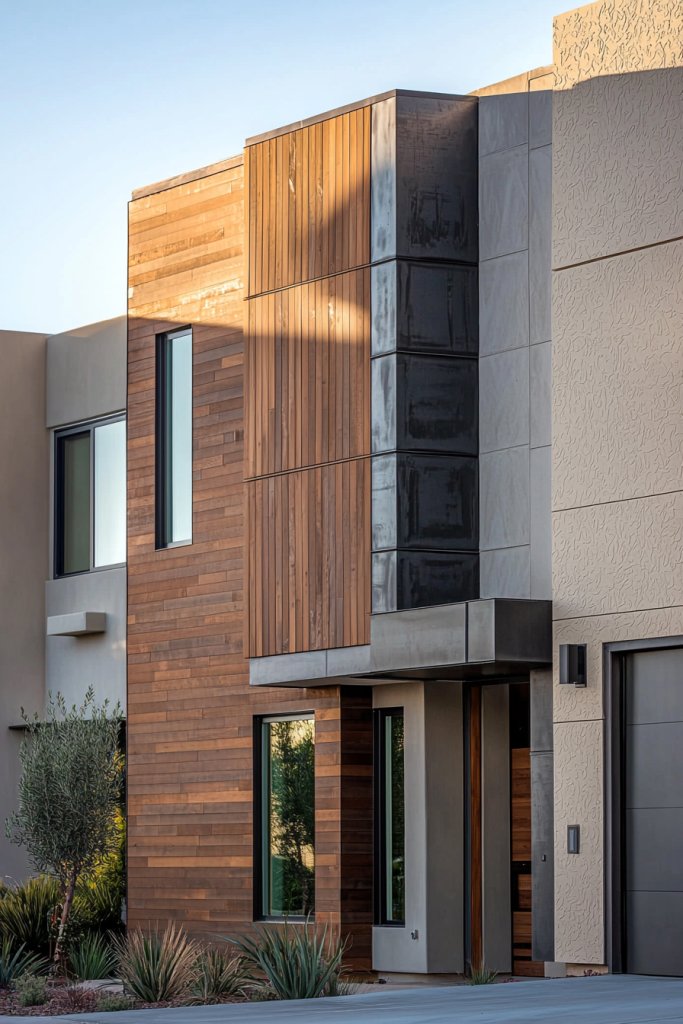
Creating a dynamic facade through the clever combination of different material finishes offers visual intrigue and modern sophistication, elevating your home’s exterior. Imagine sections of your front elevation clad in sleek, smooth stucco or plaster painted in a monochrome palette, contrasted with textured elements like natural stone veneer or matte metal panels.
These contrasting finishes break up the facade visually, highlighting architectural features such as entryways, columns, or window frames. Incorporate materials like dark-colored metal, light-colored concrete, or warm-toned stone to add depth and interest.
The interplay of textures and finishes, especially when highlighted with subtle lighting, creates a layered, contemporary look that feels both fresh and timeless. The result is a facade that captures attention and offers a rich, tactile experience.
To achieve this, start by selecting durable, weather-resistant materials suited for outdoor use. Map out your design to balance contrasting elements proportionally, ensuring they complement rather than compete with each other.
Use high-quality adhesives and fasteners for secure installation, and consider sealing or treating natural stone or wood for longevity. Experiment with different color tones and textures to find a harmonious balance, and add accent lighting to emphasize the material contrasts at night. This approach offers a highly customizable, visually engaging exterior that stands out with modern flair and sophistication.
Conclusion
With a diverse array of modern front elevation ideas—from sleek cladding and bold accents to textured wall panels and innovative lighting—there are endless ways to elevate your home’s curb appeal. Whether you prefer minimalist elegance, geometric patterns, or natural elements like vertical gardens and stone veneers, these design concepts can transform your facade into a stunning statement.
Embrace these modern ideas and give your home a fresh, captivating look that leaves a lasting impression. Start reimagining your front elevation today and turn your vision into reality!
Leave a Reply